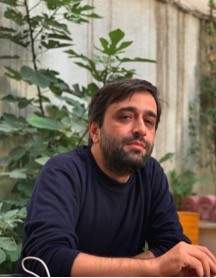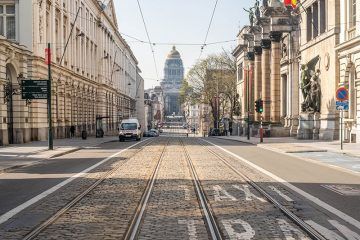Mohammad Memarian in the Los Angeles Review of Books:
 On Friday, March 20, I called my father to congratulate him on the Persian New Year. It felt gloomy, to put it mildly. We used to do it in person, shaking hands, hugging, and the three traditional kisses on the cheeks. As we are in self-quarantine, 300 miles away from each other, he acquired his very first smartphone just a week ago, rapidly catching up with technology to keep in touch with me. I watched him as he tried to turn on the selfie camera. He kept the phone so close that I could only see him with difficulty. But I could observe parts of him that usually go unnoticed: details of the wrinkles on his face, the tears he was struggling to hold back, a bruise on his left cheek, speckles I hadn’t seen before. We talked for a while, five minutes maybe, the longest routine call we had in years, and then we retreated into solitude, each into his own. The whole episode reminded me of stories of families torn apart by immigration. We are now torn apart by another, equally invisible force.
On Friday, March 20, I called my father to congratulate him on the Persian New Year. It felt gloomy, to put it mildly. We used to do it in person, shaking hands, hugging, and the three traditional kisses on the cheeks. As we are in self-quarantine, 300 miles away from each other, he acquired his very first smartphone just a week ago, rapidly catching up with technology to keep in touch with me. I watched him as he tried to turn on the selfie camera. He kept the phone so close that I could only see him with difficulty. But I could observe parts of him that usually go unnoticed: details of the wrinkles on his face, the tears he was struggling to hold back, a bruise on his left cheek, speckles I hadn’t seen before. We talked for a while, five minutes maybe, the longest routine call we had in years, and then we retreated into solitude, each into his own. The whole episode reminded me of stories of families torn apart by immigration. We are now torn apart by another, equally invisible force.
This invisible force, otherwise known as COVID-19, intruded into our lives in pretty much the same way it did into the lives of countless other people elsewhere. Except, perhaps, the context. For us Iranians, the disease came as the culmination of a long streak of unfortunate events, which inflicted upon many here a deep sense of helplessness.
More here.


 My favourite essay, Robert Douglas-Fairhurst’s ‘At Home with Tennyson’, is both a bravura work of close reading and a highly sensitive study of the poet’s loyalties, yearnings and fears about homes and homelessness. Tennyson, he demonstrates, was profoundly touched by the idea of home and ‘was equally good at evoking home when it existed only as an idea, as in “The Lotos-Eaters”, where so much of what the speaker broods over – “roam”, “foam”, “honeycomb” – has the word “home” flickering through it like a nagging but elusive memory’. Douglas-Fairhurst is yet another of the essayists here to be attracted by the word ‘nest’: Tennyson produces a ‘voice that is keen to create a nest of words for itself but also appears to be nervously eyeing up the lines of each stanza like a little set of prison bars’. This is criticism that draws quite close to the status of poetry.
My favourite essay, Robert Douglas-Fairhurst’s ‘At Home with Tennyson’, is both a bravura work of close reading and a highly sensitive study of the poet’s loyalties, yearnings and fears about homes and homelessness. Tennyson, he demonstrates, was profoundly touched by the idea of home and ‘was equally good at evoking home when it existed only as an idea, as in “The Lotos-Eaters”, where so much of what the speaker broods over – “roam”, “foam”, “honeycomb” – has the word “home” flickering through it like a nagging but elusive memory’. Douglas-Fairhurst is yet another of the essayists here to be attracted by the word ‘nest’: Tennyson produces a ‘voice that is keen to create a nest of words for itself but also appears to be nervously eyeing up the lines of each stanza like a little set of prison bars’. This is criticism that draws quite close to the status of poetry. The biopharmaceutical industry will be able to make a Covid-19 vaccine— probably a few of them—using various existing vaccine technologies. But many people worry that Covid-19 will mutate and evade our vaccines, as the flu virus does each season. Covid-19 is fundamentally different from flu viruses, though, in ways that will allow our first-generation vaccines to hold up well. To the extent that Covid does mutate, it’s likely to do so much more slowly than the flu virus does, buying us time to create new and improved vaccines. Every virus has a genome composed of genetic material (either RNA or DNA) that encodes instructions for replicating the virus. When a virus infects a cell, it accesses machinery for making copies of its genomic instructions and follows those instructions to make viral proteins that assemble, with copies of the instructions, to form more viruses (which then pop out of the cell to infect new cells, either in the same host or in someone new). There is a critical difference between coronaviruses and flu. The novel coronavirus genome is made of one long strand of genetic code. This makes it an “unsegmented” virus—like a set of instructions that fit on a single page. The flu virus has eight genomic segments, so its code fits on eight “pages.” That’s not common for viruses, and it gives the flu a special ability. Because the major parts of the flu virus are described on separate pages (segments) of its genome, when two different flu viruses infect the same cell, they can swap pages.
The biopharmaceutical industry will be able to make a Covid-19 vaccine— probably a few of them—using various existing vaccine technologies. But many people worry that Covid-19 will mutate and evade our vaccines, as the flu virus does each season. Covid-19 is fundamentally different from flu viruses, though, in ways that will allow our first-generation vaccines to hold up well. To the extent that Covid does mutate, it’s likely to do so much more slowly than the flu virus does, buying us time to create new and improved vaccines. Every virus has a genome composed of genetic material (either RNA or DNA) that encodes instructions for replicating the virus. When a virus infects a cell, it accesses machinery for making copies of its genomic instructions and follows those instructions to make viral proteins that assemble, with copies of the instructions, to form more viruses (which then pop out of the cell to infect new cells, either in the same host or in someone new). There is a critical difference between coronaviruses and flu. The novel coronavirus genome is made of one long strand of genetic code. This makes it an “unsegmented” virus—like a set of instructions that fit on a single page. The flu virus has eight genomic segments, so its code fits on eight “pages.” That’s not common for viruses, and it gives the flu a special ability. Because the major parts of the flu virus are described on separate pages (segments) of its genome, when two different flu viruses infect the same cell, they can swap pages. The coronavirus pandemic has brought chaos to lives and economies around the world. But efforts to curb the spread of the virus might mean that the planet itself is moving a little less. Researchers who study Earth’s movement are reporting a drop in seismic noise — the hum of vibrations in the planet’s crust — that could be the result of transport networks and other human activities being shut down. They say this could allow detectors to spot smaller earthquakes and boost efforts to monitor volcanic activity and other seismic events. A noise reduction of this magnitude is usually only experienced briefly around Christmas, says Thomas Lecocq, a seismologist the Royal Observatory of Belgium in Brussels, where the drop has been observed. Just as natural events such as earthquakes cause Earth’s crust to move, so do vibrations caused by moving vehicles and industrial machinery. And although the effects from individual sources might be small, together they produce background noise, which reduces seismologists’ ability to detect other signals occurring at the same frequency.
The coronavirus pandemic has brought chaos to lives and economies around the world. But efforts to curb the spread of the virus might mean that the planet itself is moving a little less. Researchers who study Earth’s movement are reporting a drop in seismic noise — the hum of vibrations in the planet’s crust — that could be the result of transport networks and other human activities being shut down. They say this could allow detectors to spot smaller earthquakes and boost efforts to monitor volcanic activity and other seismic events. A noise reduction of this magnitude is usually only experienced briefly around Christmas, says Thomas Lecocq, a seismologist the Royal Observatory of Belgium in Brussels, where the drop has been observed. Just as natural events such as earthquakes cause Earth’s crust to move, so do vibrations caused by moving vehicles and industrial machinery. And although the effects from individual sources might be small, together they produce background noise, which reduces seismologists’ ability to detect other signals occurring at the same frequency.